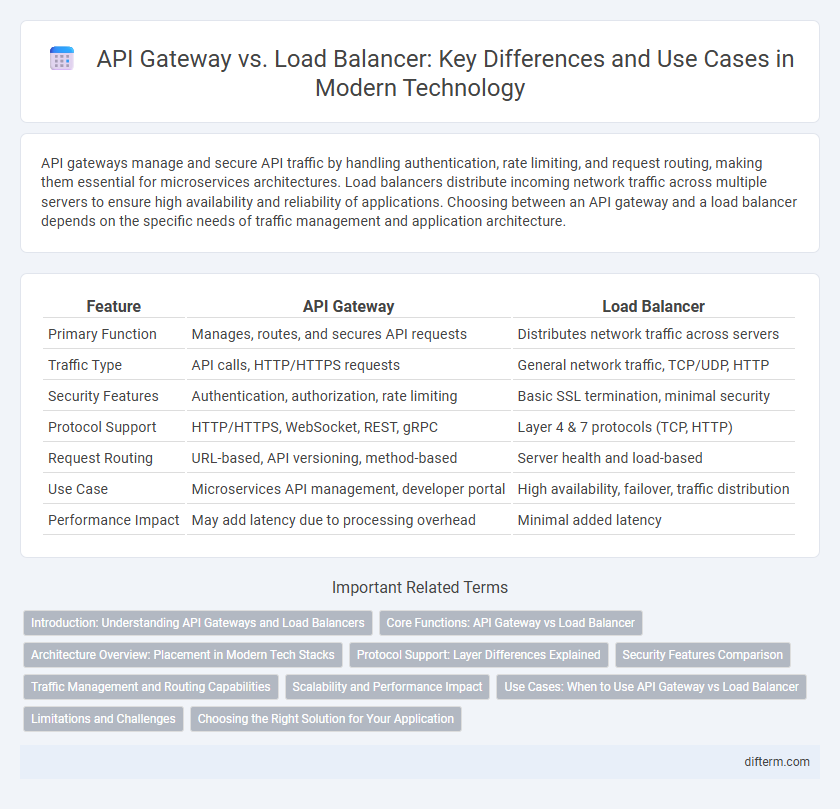API gateways manage and secure API traffic by handling authentication, rate limiting, and request routing, making them essential for microservices architectures. Load balancers distribute incoming network traffic across multiple servers to ensure high availability and reliability of applications. Choosing between an API gateway and a load balancer depends on the specific needs of traffic management and application architecture.
Table of Comparison
| Feature | API Gateway | Load Balancer |
|---|---|---|
| Primary Function | Manages, routes, and secures API requests | Distributes network traffic across servers |
| Traffic Type | API calls, HTTP/HTTPS requests | General network traffic, TCP/UDP, HTTP |
| Security Features | Authentication, authorization, rate limiting | Basic SSL termination, minimal security |
| Protocol Support | HTTP/HTTPS, WebSocket, REST, gRPC | Layer 4 & 7 protocols (TCP, HTTP) |
| Request Routing | URL-based, API versioning, method-based | Server health and load-based |
| Use Case | Microservices API management, developer portal | High availability, failover, traffic distribution |
| Performance Impact | May add latency due to processing overhead | Minimal added latency |
Introduction: Understanding API Gateways and Load Balancers
API gateways manage and route client requests to multiple backend services, providing authentication, rate limiting, and protocol translation, essential for microservices architectures. Load balancers distribute incoming network traffic across multiple servers to ensure high availability and reliability by preventing any single server from becoming a bottleneck. Both technologies optimize performance and scalability in modern web applications but serve distinct roles within the infrastructure.
Core Functions: API Gateway vs Load Balancer
API gateways primarily handle request routing, authentication, rate limiting, and protocol translation, ensuring secure and efficient API management. Load balancers distribute incoming network traffic across multiple servers to optimize resource use, maximize throughput, minimize response time, and prevent server overload. Both systems improve application performance but focus on different layers of traffic management and security enforcement.
Architecture Overview: Placement in Modern Tech Stacks
An API gateway serves as a centralized entry point that manages client requests, authentication, and routing to microservices within modern distributed architectures. In contrast, a load balancer operates primarily at the network or transport layer, distributing incoming traffic across multiple servers to enhance reliability and scalability. API gateways are typically positioned at the edge of the application layer, handling request-level operations, while load balancers sit between the client and service instances to balance server load efficiently.
Protocol Support: Layer Differences Explained
API gateways primarily operate at the application layer (Layer 7), managing and routing HTTP/HTTPS traffic, enabling protocol-specific features such as authentication, rate limiting, and transformation. Load balancers function either at the transport layer (Layer 4), distributing TCP/UDP traffic based on IP addresses and ports, or at Layer 7 for advanced routing decisions. Understanding these protocol layer differences clarifies their complementary roles: API gateways handle complex application logic while load balancers optimize network traffic distribution.
Security Features Comparison
API gateways offer advanced security features such as authentication, authorization, rate limiting, and threat detection tailored for managing API traffic, whereas load balancers primarily focus on distributing network or application traffic to optimize resource use and enhance availability without intrinsic security controls. API gateways integrate seamlessly with Identity and Access Management (IAM) systems and enforce strict access policies at the API level, providing granular security that load balancers lack. Load balancers often rely on external tools like firewalls and intrusion detection systems to address security concerns rather than providing in-built protections.
Traffic Management and Routing Capabilities
API gateways provide advanced traffic management with request routing, authentication, rate limiting, and protocol translation designed for microservices architectures. Load balancers primarily distribute incoming network traffic across multiple servers to ensure high availability and reliability, focusing on failover and server health checks. API gateways offer more granular routing rules based on API endpoints and user context, while load balancers operate mainly at the transport and application layer for efficient load distribution.
Scalability and Performance Impact
API gateways streamline microservices communication by centralizing request routing, authentication, and rate limiting, which enhances scalability through efficient traffic management and reduces latency. Load balancers distribute incoming network traffic across multiple servers, improving application performance and availability by preventing server overload and ensuring resource optimization. Combining API gateways with load balancers maximizes scalability and performance by leveraging centralized API management alongside robust traffic distribution.
Use Cases: When to Use API Gateway vs Load Balancer
API gateways are ideal for managing, securing, and routing API requests in microservices architectures, offering features like authentication, rate limiting, and request transformation. Load balancers distribute incoming network traffic across multiple servers to ensure high availability and reliability, primarily optimizing performance and fault tolerance for web applications. Use API gateways when controlling API traffic with advanced routing and security policies is essential, and opt for load balancers when the main goal is scaling backend services by evenly spreading user requests.
Limitations and Challenges
API gateways often face challenges related to latency and throughput limitations when handling large volumes of encrypted traffic, impacting overall application performance. Load balancers may struggle with session persistence and lack deep protocol awareness, limiting their ability to manage complex API interactions effectively. Both components require careful configuration and scaling strategies to mitigate bottlenecks and ensure seamless routing and security enforcement in distributed architectures.
Choosing the Right Solution for Your Application
API gateways manage client requests by routing, authentication, and protocol translation, making them ideal for microservices and complex APIs that require security and monitoring. Load balancers distribute incoming network traffic across multiple servers to ensure high availability and reliability, best suited for optimizing resource use and improving application performance. Selecting the right solution depends on the application's architecture and needs: use an API gateway for API management and microservices, and a load balancer for efficient traffic distribution and fault tolerance.
API gateway vs Load balancer Infographic

 difterm.com
difterm.com